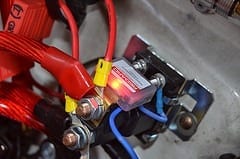The hope is that at least one of the tubes will start a revolution
KRIS PUPEK, an industrial chemist at Argonne National Laboratory in Lemont, near Chicago, waves a tube of white powder in the air emphatically. A mere pinch of the contents is sufficient for his analytical colleagues to work out if it has the potential to be the next whizzy material in battery research. But Dr Pupek does not deal in pinches. His job is to find out whether potential can be turned into practice—in other words, whether something that has the right properties can be made cheaply, and in bulk. If it can, it is passed on to industry for testing. The hope is that at least one of the tubes will start a revolution.
Batteries are a hugely important technology. Modern life would be impossible without them. But many engineers find them disappointing and feel that they could be better still. Produce the right battery at the right price, these engineers think, and you could make the internal-combustion engine redundant and usher in a world in which free fuel, in the form of wind and solar energy, was the norm. That really would be a revolution.
It is, however, a revolution that people have been awaiting a long time. And the longer they wait, the more the doubters wonder if it will ever happen. The Joint Centre for Energy Storage Research (JCESR), at which Dr Pupek and his colleagues work, hopes to prove the doubters wrong. It has drawn together the best brains in energy research from America’s national laboratories and universities, along with a group of interested companies. It has money, too. It has just received a grant of $120m from the country’s Department of Energy. The aim, snappily expressed, is to make batteries five times more powerful and five times cheaper in five years.
Think positive
Most batteries, from the ancient, lumbering lead-acid monsters used to start cars, to the sleek, tiny lithium cells that power everything from e-book readers to watches, have three essential components: two electrodes (an anode and a cathode) and a medium called an electrolyte that allows positively charged ions to move between the electrodes, balancing the flow of negatively charged electrons that form the battery’s useful current. The skill of creating new types of battery is to tinker with the materials of these three components in ways that make things better and cheaper. Dr Pupek’s white powders are among those materials.
To discover more of them, Argonne will make use of a rapidly growing encyclopedia of substances created by Gerbrand Ceder of the Massachusetts Institute of Technology. Dr Ceder runs the Materials Project, which aims to be the “Google of material properties”. It allows researchers to speed up the way they search for things with specific properties. Argonne will use the Materials Project as a reference library in its search for better electrodes, and also hopes to add to it.
via The Economist
The Latest Streaming News: Storing electricity updated minute-by-minute
Bookmark this page and come back often
Latest NEWS
Latest VIDEO








